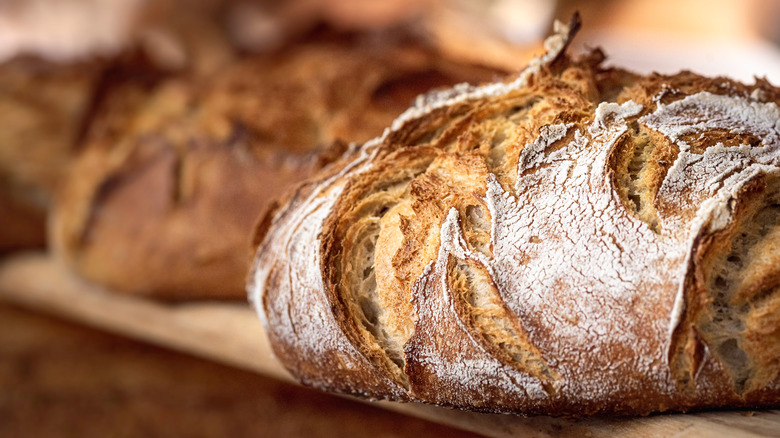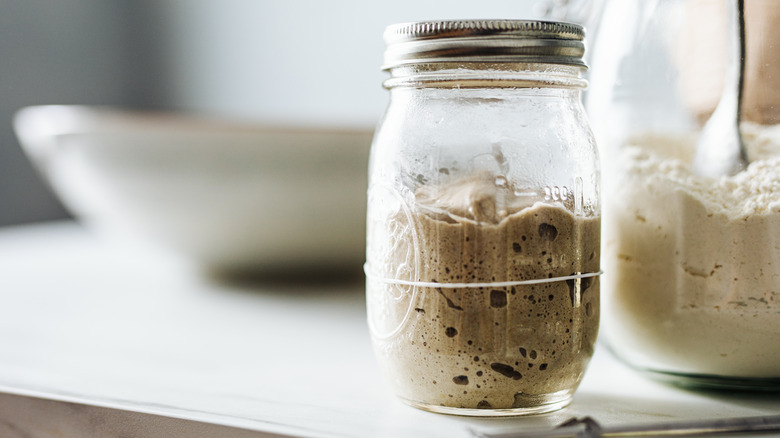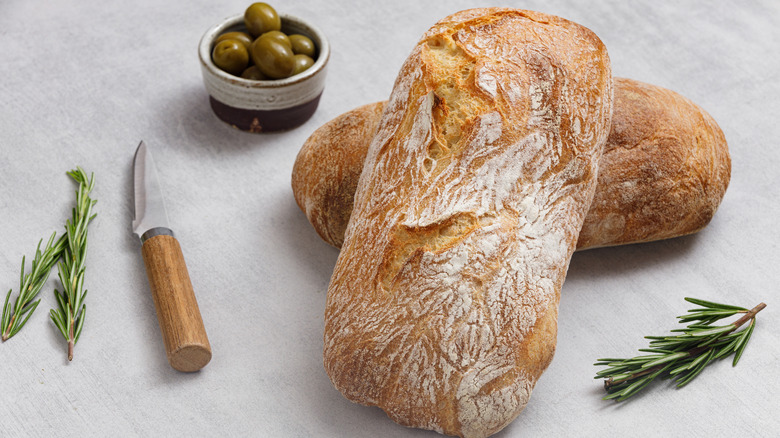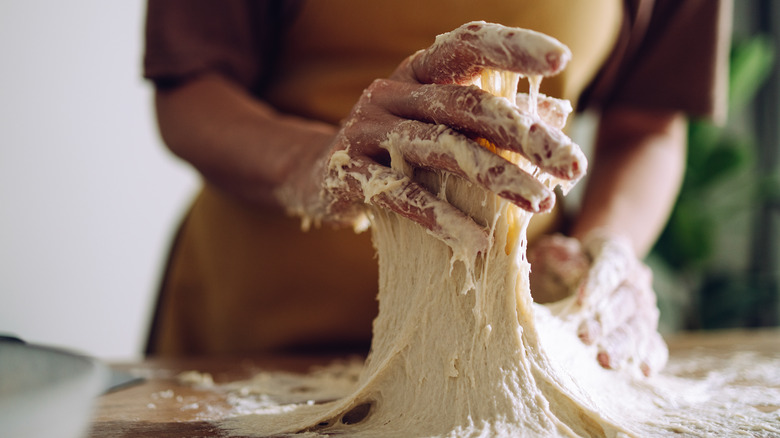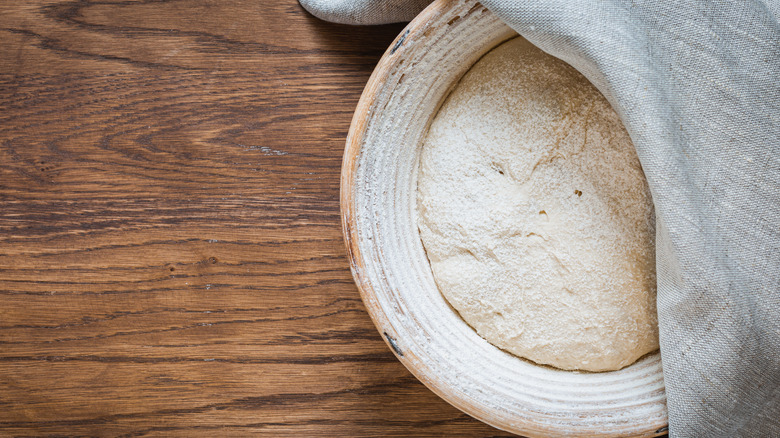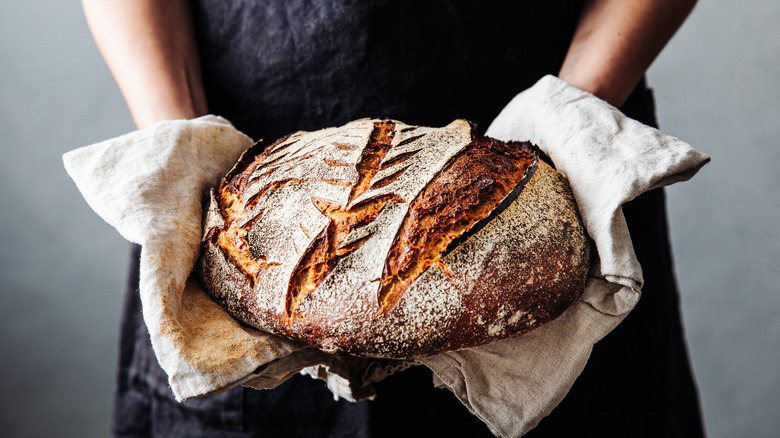The Differences Between Ciabatta And Sourdough Bread
With a rustic and artisanal vibe, ciabatta and sourdough are the stars of a bakery aisle in any grocery store. If you're putting fancier sandwiches on your weekly lunch plans, you'll probably be reaching for one of the two: The question is, what's the difference between them, and which one would be better for what you have in mind?
The biggest difference, of course, comes down to a matter of taste. Sourdough is named for its distinctly tangy flavor that adds complexity to any sandwich or topping, while ciabatta is much milder with a simpler flavor profile. While they both have light and airy crumbs, ciabatta is shaped so that the crust forms the outer layer of a sandwich and is better suited to holding up heavier or more moist ingredients. If you're going the homemade route, it's also important to know that sourdough takes a lot longer to prep than ciabatta, though it takes fewer ingredients.
What is sourdough?
Sourdough is one of the oldest forms of bread with a history that stretches past ancient Egypt and possibly into the very first human civilizations. More a method of baking than a distinct genre of bread, sourdough is made from fermenting flour and water with the natural yeast in the air to create a live starter culture. Then a portion of this starter is taken and mixed into a new dough to act as the natural leavening agent. Meanwhile, the starter is then kept "alive" via regular feedings of more flour and water for easy and quick access to yeast for future loaves of bread.
Despite most likely originating in the cradle of civilization — what's now known as the Middle East — sourdough as a baking technique was unimaginably widespread, even in ancient times. One of the first pieces of sourdough ever discovered was unearthed in Switzerland and dated for around 3700 BCE. Because sourdough fermentation only needs flour, water, and a warm environment to sit in, it's likely that the technique arose independently in cultures across the continents via accidents or experimentations.
While it's been replaced by commercial yeast as the most common leavening agent as of the 19th century, sourdough starters have made a 21st-century comeback as many people took to baking as a pandemic hobby. Sourdough's extremely minimalistic ingredient list and complex flavor profile make it both accessible and attractive to novice bakers anywhere.
What is ciabatta?
In contrast to the ancient and almost ubiquitous sourdough, ciabatta has a very recent and highly regional origin. The story of ciabatta starts in 1980s Italy, where it was invented to spite the French baguette's increasing popularity as a sandwich bread that was on the verge of taking over Italy's sandwich market. Arnaldo Cavallari, a miller in northeastern Italy, took it upon himself to create the perfect sandwich canvas that would be a market-viable counter to the baguette imports. With an airy and light taste but a sturdy density and structure, this new competitor bread was named "slipper" in Italian because of its shape and was released to the world for sandwich domination. By the mid to late nineties, it had become popular enough in Britain to become a staple at grocery stores around the same time that it was beginning to gain a foothold in the U.S. Nowadays, it's a regular in any grocery store's premium bread aisles and holds a privileged reputation as an artisanal sandwich base.
Ciabatta is a much higher hydration bread
You may have heard that you need to use a stand mixer to knead ciabatta dough; while this isn't a strict necessity in terms of the recipe or bread quality itself, it's a general good practice to save yourself a great deal of trouble. The fact is, ciabatta is a particularly high-hydration bread — in baker's percentages, it typically has 80% or higher hydration and can get quite sticky and difficult to work with during the kneading process.
Because of this, it also needs a longer kneading process. The flour-to-water ratio being so unbalanced means that it's quite unstable as far as molecular structure goes. While you've probably heard many times that you should always be careful to never overwork your dough, ciabatta is the one exception that needs a great deal of kneading and folding to coax the gluten into sturdier compositions. Some recipes will instruct you to carefully knead the risen dough in intervals of 30 to 45 minutes, letting the dough rise in between sets of kneading. Once baked, this results in a dense yet soft texture that makes it perfect for supporting sandwiches with lots of heavy and/or moist ingredients.
Sourdough takes longer to make
By contrast, sourdough needs extra gentle kneading because of much lower hydration as well as the nature of using live yeast to leaven the dough. Too much activity could very easily lead to over-oxidation, which mucks up the flavor as well as the texture. While different recipes have different instructions, sourdough will typically need somewhere between 15 to 20 minutes of folding.
Due to the nature of sourdough, it will also need a much longer fermentation period. While the commercial yeast in ciabatta takes very little time to activate and do its job, the live culture in sourdough needs time to work its ancient and mostly unchanged magic. Depending on the age and robustness of your starter culture, the kind of flour you're using in the dough, and the general temperature and environment you're proofing the dough in, sourdough can take anywhere from a handful of hours to the better part of a day to fully rise into an oven-ready form.
Sourdough is more nutritious and has a stronger flavor
The tradeoff to the inconvenience of sourdough's long prep time is that it's more nutritious than ciabatta as well as other types of white bread. According to the USDA, 100 grams of the average loaf of sourdough has more protein, fiber, calcium, and no sugar compared to 100 grams of the average ciabatta. Sourdough also has a good deal of potassium whereas ciabatta has none. Furthermore, the lactic acid produced in sourdough's fermentation process makes it easier to digest and boosts the antioxidant content in the bread.
That's not to say that ciabatta doesn't also have its own benefits, however. While sourdough's acidic and strong taste is perfect for complementing as well as cutting through richer flavors in a sandwich, it can be off-putting to many. Ciabatta has a much milder taste that's more universally appealing as a sandwich base. Not to mention, its shape makes it much better at holding in any moist or melty ingredients, whereas slices of sourdough are prone to losing a few pieces through the large holes. If super-soft cheeses like bocconcini make an appearance in your sandwich, you'll probably want to grab the ciabatta instead.
